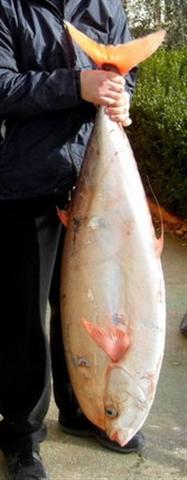
The Moorish idol is a species of marine ray-finned fish belonging to the family Zanclidae. It is the only member of the monospecific genus Zanclus and the only extant species within the Zanclidae. This species is found on reefs in the Indo-Pacific region.

Ephippidae is a family of percomorph fishes, the spadefishes, in the order Moroniformes. These fishes are found in the tropical and temperate oceans of the world, except for the central Pacific.
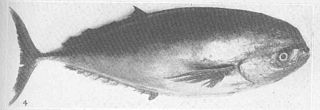
Luvaridae is a family of marine ray-finned fishes belonging to the suborder Acanthuroidei in the order Acanthuriformes, of which they are the only pelagic members. The family has a single extant species, the widespread louvar and a small number of known extinct species.

Luvarus is a genus of ray-finned fishes belonging to the family Luvaridae. It is the only extant genus in that family and its only extant species is the cosmopolitan louvar.
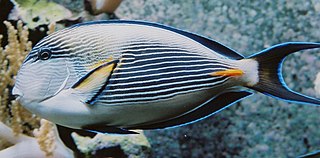
The sohal surgeonfish or sohal tang, is a species of marine ray-finned fish belonging to the family Acanthuridae, which includes the surgeonfishes, unicornfishes and tangs. This fish is found in the northwestern Indian Ocean.

Acanthurus nigroris, the bluelined surgeonfish, is a species of marine ray-finned fish belonging to the family Acanthuridae, which includes the surgeonfishes, unicornfishes and tangs. This species and A. nigros have been regarded as synonymous with the combined taxon having a wide Indo-Pacific distribution, if treated as a separate valid species it is confined to the United States Pacific islands.

Acanthurus pyroferus, chocolate surgeonfish, mimic surgeonfish, orange-gilled surgeonfish, Pacific mimic surgeon, and yellowspot surgeon, is a species of marine ray-finned fish belonging to the family Acanthuridae, which includes the sugeonfishes, unicornfishes and tangs. This species is found in the Indo-Pacific region.

Acanthurus nigricans, the goldrim surgeonfish, velvet surgeon, whitecheek surgeonfish, yellow-banded surgeonfish or yellowrimmed surgeonfish, is a species of marine ray-finned fish belonging to the family Acanthuridae, the surgeonfishes, unicornfishes and tangs. This species is found from the central Indo-Pacific area to the eastern Pacific coast, Hawaii included.

Acanthurus maculiceps, the white-freckled surgeonfish, yellow-freckled surgeonfish, pale-lined surgeonfish,spotted-faced surgeonfish or earbar surgeonfish, is a species of marine ray-finned fish belonging to the family Acanthuridae, the surgeonfishes, unicornfishes and tangs. This species is found in the Indo-West Pacific region.

Acanthurus nigrofuscus, the brown surgeonfish, blackspot surgeonfish, brown tang, dusky surgeon, lavender tang or spot-cheeked surgeonfish, is a species of marine ray-finned fish belonging to the familyAcanthuridae, which includes the surgeonfishes, unicornishes and tangs. This species is a common and abundant fish occurring across a wide Indo-Pacific range.

Acanthurus albipectoralis, the whitefin surgeonfish, is a species of marine ray-finned fish belonging to the family Acanthuridae, the surgeonfishes, unicornfishes and tangs. This species is found in the Western Pacific Ocean.
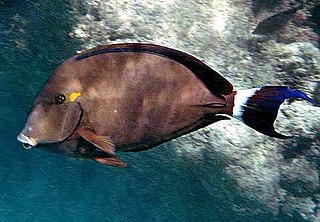
Acanthurus blochii, the ringtail surgeonfish or dark surgeonfish, is a marine ray-finned fish belonging to the family Acanthuridae, the surgeonfishes, unicornfishes and tangs. This fish is found in the Indo-Pacific.

Acanthurus auranticavus, the ringtail surgeonfish or orange-socket surgeonfish, is a species of marine ray-finned fish belonging to the family Acanthuridae, the surgeonfishes, unicornfishes and tangs. This species is found in the Indo-West Pacific.

Acanthurus fowleri, Fowler's surgeonfish or the horseshoe surgeonfish, is a species of marine ray-finned fish belonging to the family Acanthuridae, the surgeonfishes, unicornfishes or tangs. This fish is found in the Western Pacific Ocean.
Acanthurus reversus is a species of marine ray-finned fish belonging to the family Acanthuridae, which includes the surgeonfishes, unicornfishes and tangs. This fish is endemic to French Polynesia.
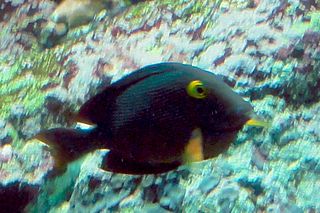
Ctenochaetus marginatus, the blue-spotted bristletooth, blue-spotted surgeonfish or striped-fin surgeonfish, is a species of marine ray-finned fish belonging to the biology Acanthuridae which includes the surgeonfishes, unicornfishes and tangs. The blue-spotted bristletooth is found in the central and eastern Pacific Ocean.

Naso elegans, the elegant unicornfish, the blonde naso tang, Indian orange-spine unicorn, lipstick surgeonfish, lipstick tang, orangespine unicornfish or smoothheaded unicornfish, is a species of marine ray-finned fish belonging to the family Acanthuridae, the surgeonfishes, unicornfishes and tangs. This species is found in the Indian and western Pacific Oceans.
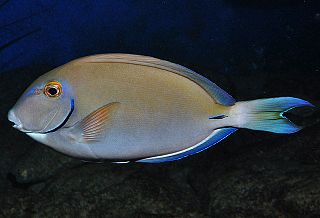
Acanthurus tractus, the five-band surgeonfish, ocean surgeon, or ocean surgeonfish, is a species of ray-finned fish in the family Acanthuridae found in the western Atlantic Ocean, Florida, the Bahamas, the Caribbean Sea and the Gulf of Mexico. Until recently, it was considered a synonym of Acanthurus bahianus, but its status as a separate species was resurrected in 2011.
The whitechin surgeonfish is a species of marine ray-finned fish belonging to the family Acanthuridae, the surgeonfishes, unicornfishes and tangs. It is endemic to the waters of the western Pacific Ocean in the Philippines.
The grey-head surgeonfish is a species of marine ray-finned fish belonging to the family Acanthuridae which includes the surgeonfishes. unicornfishes and tangs. This species has a wide Indo-Pacific distribution.



